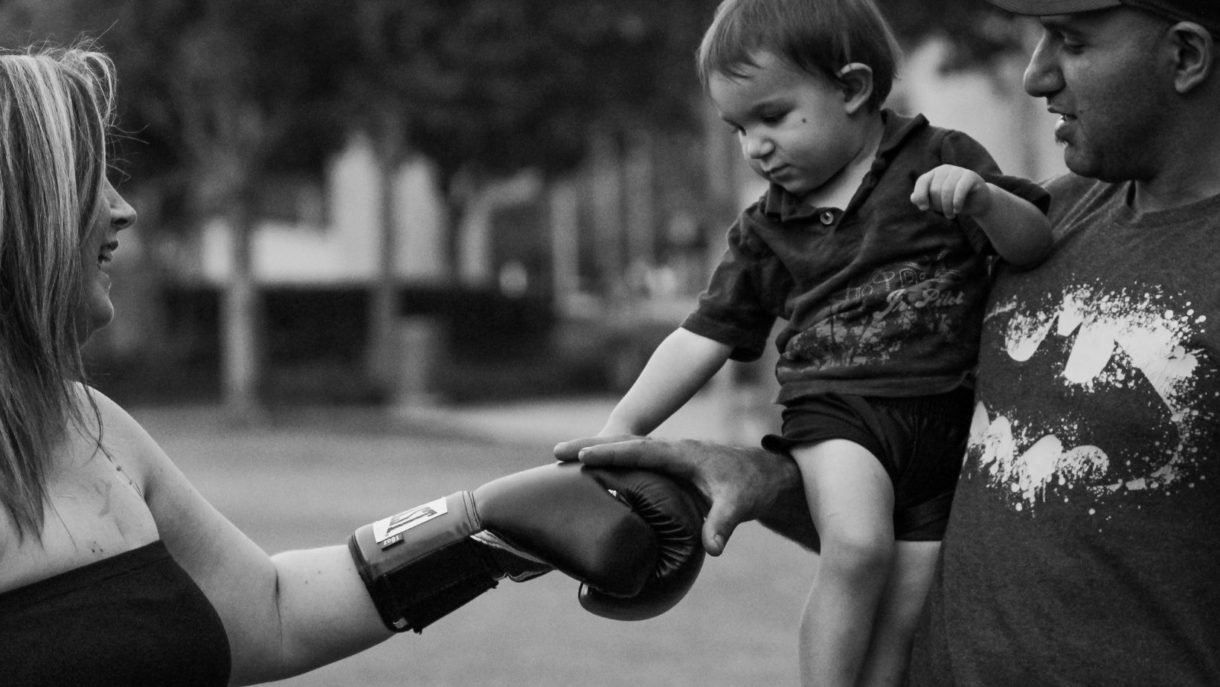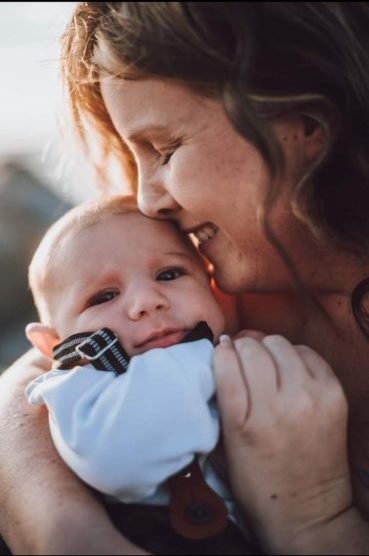Historia destacada de un sobreviviente:
Maternidad y melanoma: Raleigh Minning, sobreviviente de melanoma en estadio III

Por Mara Klecker
Una de las únicas veces que Raleigh Minning lloró durante su melanoma Fue entonces cuando pensó en la posibilidad de que su hijo recién nacido no tuviera recuerdos de ella si la enfermedad le quitaba la vida.
Ella acababa de someterse a una cirugía completa. la linfa disección de ganglios linfáticos—sólo semanas después de dar a luz—y todavía estaba tratando de amamantar y extraer leche para su bebé, a pesar del dolor. linfedema en su pecho. Su esposo y su madre tuvieron que ayudarla a levantar físicamente al bebé Atticus hasta el pecho de Raleigh para amamantarlo.
“Fue un momento muy vulnerable”, dijo.
 Luego vino la infección, que hizo que su temperatura subiera a un nivel peligroso. Estuvo en el hospital durante una semana y siguió extrayéndose leche, alternando entre hielo y compresas calientes para aliviar el dolor. Su marido se llevaba la leche a casa y la guardaba, pero ella no se dio cuenta de que estaba alimentando al bebé con fórmula por precaución. Estaba preocupado por lo que le pasaría a su bebé. antibióticos Ella estaba embarazada y si podía afectar a Atticus. Cuando regresó a casa del hospital, encontró toda la leche que tanto le había costado extraer y terminó tirándola.
Luego vino la infección, que hizo que su temperatura subiera a un nivel peligroso. Estuvo en el hospital durante una semana y siguió extrayéndose leche, alternando entre hielo y compresas calientes para aliviar el dolor. Su marido se llevaba la leche a casa y la guardaba, pero ella no se dio cuenta de que estaba alimentando al bebé con fórmula por precaución. Estaba preocupado por lo que le pasaría a su bebé. antibióticos Ella estaba embarazada y si podía afectar a Atticus. Cuando regresó a casa del hospital, encontró toda la leche que tanto le había costado extraer y terminó tirándola.
“Ese fue el momento para mí”, dijo. “Pensé: 'Está bien, ya no puedo amamantar a mi bebé. Soy una... células cancerosas “Paciente. Ni siquiera puedo levantar a mi propio bebé”.
El diagnóstico inicial de Raleigh en octubre de 2018 se estadificó en pT1a, o Fase IA Se sometió a una escisión local amplia y pensó que no tenía mucho más de qué preocuparse aparte de la rutina. piel exámenes. Luego, a las 34 semanas de embarazo de Atticus, Raleigh sintió un bulto del tamaño de una pelota de golf en la axila.
“Supe de inmediato que el cáncer había regresado”, dijo. Eso fue en noviembre de 2019.
Tenía una cita con el ginecólogo al día siguiente y su médico la envió a un biopsia y ultrasonido De inmediato. El melanoma de Raleigh se había propagado superficialmente y ahora estaba en la etapa IIIC.
“Creo que la ginecóloga también estaba incrédula, porque no era algo con lo que estuviera muy familiarizada”, dijo Raleigh. Fue la primera de muchas veces en las que se dio cuenta de lo poco que se sabe sobre el melanoma y el embarazo.
De hecho, la Dra. Isabella Glitza, una especialista en melanoma medico oncologo en el MD Anderson Cancer Center, que actualmente está recopilando datos de pacientes embarazadas con melanoma de todo el mundo, dice que todavía hay muy pocos datos disponibles sobre cómo el embarazo afecta el melanoma.
En el caso de Raleigh, la prioridad rápidamente pasó a ser conseguir el nacimiento del bebé para que Raleigh pudiera comenzar el tratamiento. Le indujeron el parto un domingo y tenía previsto visitar al médico. dermatólogo, oncólogo y oncólogo quirúrgico el lunes. Pero el equipo no llegó el lunes. Entonces Raleigh, una maestra ahora jubilada, comenzó a abogar por sí misma, recurriendo a la distribución de una presentación en PowerPoint que había hecho con información que había reunido de AIM en Melanoma, así como de su patología informes.
“Nunca pensé que mi plan de parto también sería lo que me ayudaría a salvar la vida”, dijo.

“Tenía 33 años. No es algo en lo que uno deba pensar a esa edad”.
Raleigh exigió una resonancia magnética cerebral que salió normal, lo que según ella realmente le dio munición para seguir luchando.
“Crees que estás agotada cuando tienes un bebé”, dijo. “Imagínate tener un bebé nuevo y un melanoma y tener que defenderte por completo, todo al mismo tiempo”. Eso ni siquiera cuenta el hecho de ser madre de sus otros dos hijos, que ahora tienen 13 y 14 años.
Aún así, la verdadera lucha no comenzó hasta después de que ella fue dada de alta del hospital.
Raleigh sólo pudo mecer a su bebé y bailar con él en brazos durante dos semanas antes de la disección de los ganglios linfáticos y las numerosas complicaciones (infección y linfedema) que vinieron después. Poco tiempo después, comenzó a Opdivo (nivolumab) y radiación.
Ella recuerda estar sentada en una mesa de restaurante con su esposo revisando folletos sobre inmunoterapia drogas.
“Tenía 33 años. No es algo en lo que uno deba pensar a esa edad”, dijo.
Los tratamientos desencadenaron una serie de negativas Efectos secundarios: quemadura por radiación, hipotiroidismo, dolor muscular en las piernas y erosión de la córnea en los ojos.
Cuatro meses después de que terminara su tratamiento y los médicos no declararan evidencia de enfermedad, Raleigh acudió al ginecólogo para que le extirpara algunos pólipos que los médicos creían que aparecían como "puntos calientes" en exploraciones PET anteriores. Raleigh, sintiendo que no quería someterse a tratamientos para el melanoma ni a otro bebé, decidió hacerse una histerectomía.
 ¡Pero sorpresa! En su consulta de abril de 2021, descubrió que ya estaba embarazada.
¡Pero sorpresa! En su consulta de abril de 2021, descubrió que ya estaba embarazada.
Está previsto que nazca en diciembre, pero planean inducir el parto en noviembre. La bebé, una niña, es activa, dijo Raleigh, y suele sonreír en las fotos de la ecografía.
Debido al embarazo, Raleigh no ha podido hacerse exploraciones PET para verificar si el cáncer ha regresado.
"Creo que ahora tengo 'ansiedad por las pruebas'", dijo. "Da miedo pensar que el cáncer podría estar creciendo y yo no lo sé", dijo.
Aun así, se aferra a la creencia de seguir adelante y concentrarse en el siguiente paso. Como ella misma lo expresa: “La preocupación es como una mecedora: te lleva de un lado a otro, pero nunca hacia adelante”.
También recuerda un dicho que alguien le dijo al principio de su lucha contra el melanoma: “Está bien gatear antes de correr”. Como madre y maestra, se había acostumbrado a cuidar a los demás, pero el melanoma le enseñó a ser vulnerable y a centrarse en ese pequeño paso siguiente, dijo.
Todo esto se le hacía mucho más fácil cuando pensaba en sus hijos. Estaba decidida a no dejar que la vieran tirada en el sofá, con aspecto derrotado.
“A medida que mis hijos crezcan, quiero que sepan que hice esto por ellos”, dijo. Por un momento, planeó hacer un libro o un video con consejos para transmitirles a sus hijos si no podía estar allí para ellos mientras crecían. Pero se quedó paralizada cuando se le ocurrió pensar en palabras sabias en el momento.
“Tendrán que recibirlo directamente de mí y yo tengo que estar aquí para decírselo”, afirmó. “Ellos son mi fuerza en todo esto”.
Para obtener más información sobre el programa de apoyo entre pares de AIM, haga clic en
Publicaciones Recientes

El costo del protector solar podría costar vidas

Una conversación con la Dra. Rena Szabo, PsyD, sobre el empoderamiento de los pacientes

Empoderamiento de las mujeres en el melanoma: Una mirada al interior de la Iniciativa Mujeres en el Melanoma

Noticias y aspectos destacados sobre el melanoma que no querrás perderte

Afrontar el cáncer: Habilidades de TCD para la resiliencia emocional
Filtrar por Tag
- Blog - Melanoma360335
- Noticias de última hora57
- Amigos, familiares y cuidadores21
- En inglés simple21
- Historias de defensores internacionales6
- Melanoma por parte del Estado13
- Investigación sobre el melanoma81
- Filantropía45
- Podcast44
- carta del presidente18
- Efecto secundario central2
- Historias de sobrevivientes50
- Otros5

